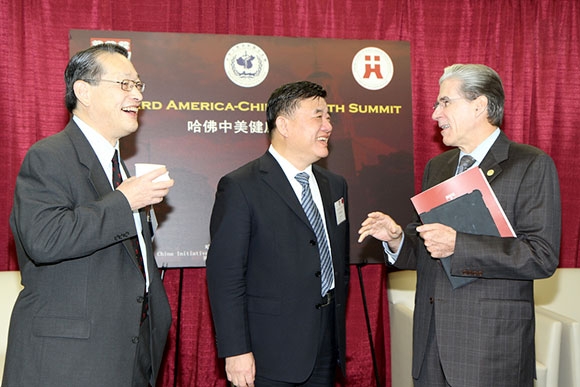Sharing the Quest for Excellence in Human Resources for Health

The second China-US Health Summit, with 1,000 people in attendance, was conducted at the National Convention Center in Beijing on October 30-31, 2012. The Summit compared US-China health reforms, discussing the ways in which each country is striving to strengthen human resources for health. At the summit, CMB President Lincoln Chen highlighted how medical educators and policy makers in the two countries are diversifying the composition of their health workforces and designing policies to attract and retain primary care providers in rural areas.
While US and China face similar challenges, they have very different health care systems. In 2008, US health expenditures accounted for 15.3% of GDP in comparison to 4.6 % in China. On a per capita basis, the US spends $6,719 and China $94. Also striking is the divergence in types of primary care providers produced in each country. In 2008, China graduated 185,000 doctors and 29,000 nurses, while the United States graduated 19,000 doctors and 74,000 nurses. Moreover, the US has adopted workforce diversity to reach remote rural areas, where nurse practitioners and physician assistants comprise 43% and 16% of the primary care workforce.
China has set ambitious goals for its health professional workforce, aiming to have 300,000 general practitioners by 2020. It is also offering generous tuition incentives to medical students who will commit to spend six years after graduation working in a rural township clinic.
Dr. Chen cited examples of how other countries are bringing greater pluralism into their health workforces, which China may want to consider as it seeks to reach underserved populations. In Brazil, 246,000 community health agents now reach 63% of the population. Pakistan’s lady health visitors are now the first health workers for 17% of those seeking care. Bangladesh has deployed 100,000 shasto shabika, or village health workers, to provide service in rural areas. Countries also are making greater efforts to attract rural students to health careers, set up medical schools in rural areas, and raising the social status of rural service, among other steps.
China and the United States’ shared quest for excellence in human resources can enable them to achieve their goals of universal access and equitable health coverage, Dr. Chen concluded, by having the right workers in the right place and the right time, providing the right services.
